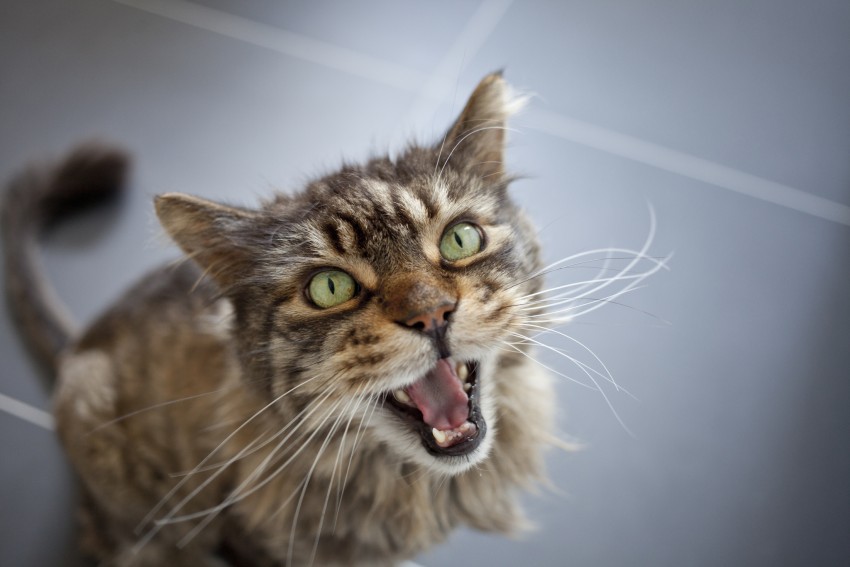
Why does my cat meow so much?
If you’re like me, you want to know what your cat is trying to convey (especially when they won’t shush).
From just saying “hello” to simply being hungry, here are some possible explanations for constant meowing.
7 Reasons a Cat May Be Meowing a Lot
1. Your cat simply wants attention.
Maybe this is because the cat wants to play, or they’re bored.
Don’t respond every time your cat meows — instead, give them attention when they get quiet. If your cat keeps meowing, walk away until they calm down.
Walking away is for excessive meowing, but do be sure to spend time with your cat every day (they are part of your family, after all). Playing with your cat also provides a proper amount of exercise, essential for their well-being.
Keep rewarding the quiet behavior and ignoring the constant meowing. Rewarding your cat for their calmness can help curb the noises, but it might still be a long process.
2. Your cat is sick.
Meowing is one way a cat communicates, and your cat may be trying to tell you that they don’t feel well.
Cats are good at hiding illnesses, and meowing or making noise without showing interest in food could be a sign of a health problem that needs attention.
Constant cat meowing could indicate an overactive thyroid, kidney disease, problems urinating or a host of other health issues. If this behavior is something new in your cat, it’s worth a trip to the veterinarian.
3. Your cat is hungry.
Some cats may meow for only 2 things: a litter box–related reason or food.
If the food bowl is empty, your cat let you know by meowing a lot.
Make sure your cat is getting enough food and is eating at the appropriate times. And while you’re at it, check the water bowl, too.

4. Your cat is stressed.
Changes in the home, new people, new animals or other causes could stress your cat out.
If your cat is meowing a lot during these changes, it could be an occasional “I don’t like this” meow or a constant and loud “I’m really mad about this!” noise.
Of course, your cat can’t tell you this, so keep an eye out for new changes that may upset them and interact with them as much as you can. If you are adding an animal to your household, properly socialize the new pet with your cat to avoid behavioral issues.
5. Your cat is old and confused.
Cats, like people, can become forgetful or confused in old age.
Was YOUR Pet Food Recalled?
Check Now: Blue Buffalo • Science Diet • Purina • Wellness • 4health • Canine Carry Outs • Friskies • Taste of the Wild • See 200+ more brands…

Disorientation is not uncommon, and your cat may meow out of frustration or confusion. Leave a light on at night if your cat vocalizes then or if they are bumping into things.
Especially if your older cat isn’t just “talking” to you but is yowling very loudly, then please see the vet.
Finding and treating the underlying cause can do a lot more than give you back a good night’s sleep — it can add happy years to your cat’s life, as Dr. Debora Lichtenberg, VMD, explains in her article “Why Does My Older Cat Yowl All the Time?”
Why does my cat meow so much? Check out the range of noises this little meow-machine makes:

6. Your cat is in heat.
Female cats in heat can become very vocal suddenly. They do this to attract males. Males are also noisy if they detect a cat in heat nearby.
Do yourself and the feline overpopulation problem a favor — have your girl spayed.
7. Your cat just wants to tell you hello.
Sometimes your cat may be meowing to say hi. It’s as simple as that.
Please: Do Not Yell at Your Cat for Meowing
Interact with your cat and try to calm them if the vocalizations become worrisome.
Don’t scold your cat for meowing. Apart from not being nice, this may cause fear and insecurity — which would mean further behavioral issues.
References
- “Meowing and Yowling.” ASPCA. https://www.aspca.org/pet-care/cat-care/common-cat-behavior-issues/meowing-and-yowling.
- Yin, Sophia, DVM. “Cat Constantly Meows and Drives Owner Crazy.” Cattle Dog Publishing. Aug. 17, 2009. https://drsophiayin.com/blog/entry/cats_constant_meowing_is_driving_owner_crazy/.
- Newman, Aline Alexander, and Gary Weitzman, DVM. How to Speak Cat: A Guide to Decoding Cat Language. National Geographic Books. 2015.
- Moore, Arden. The Cat Behavior Answer Book: Practical Insights & Proven Solutions for Your Feline Questions. Storey Publishing. 2007.
* * *
This article was originally published in 2015 and is regularly updated. It was last reviewed for accuracy and updated on Aug. 24, 2019.


